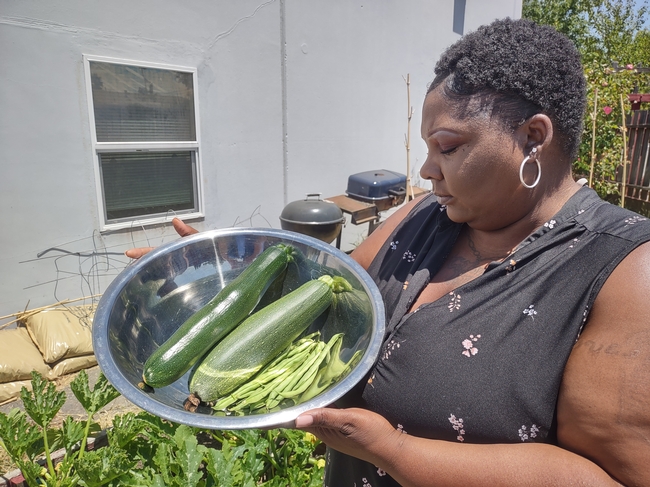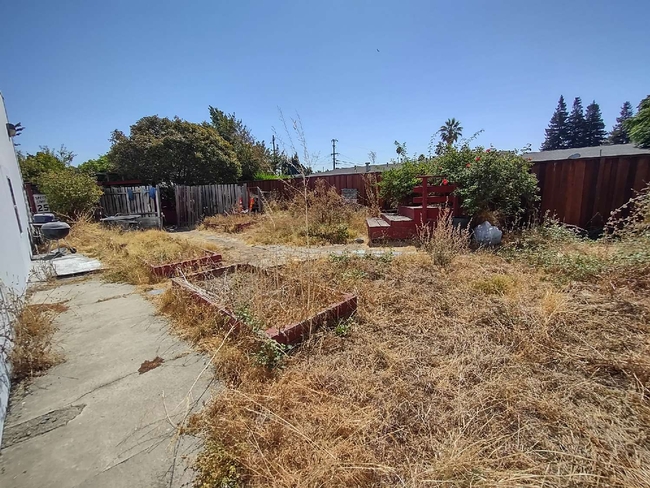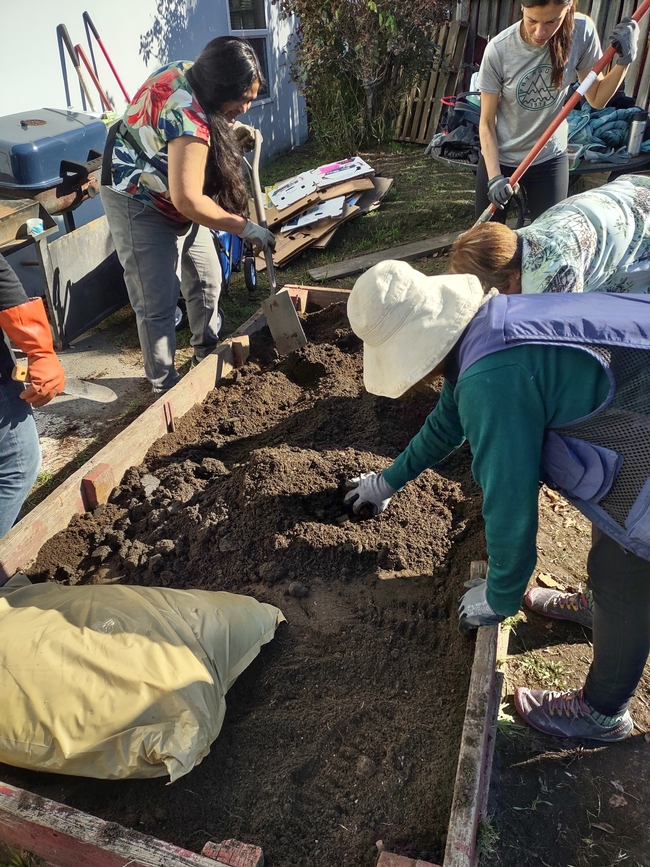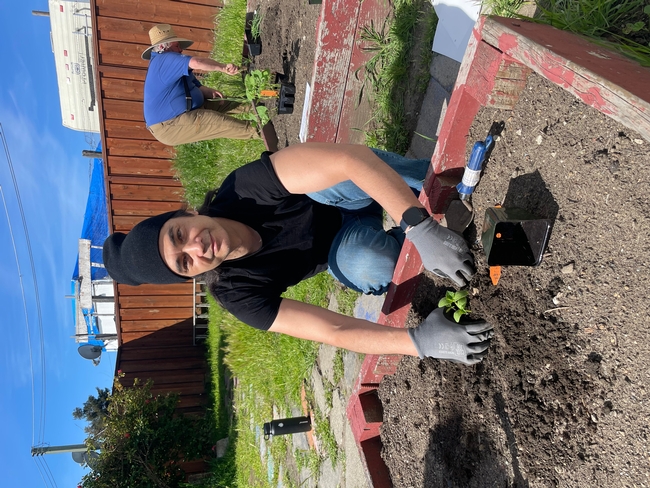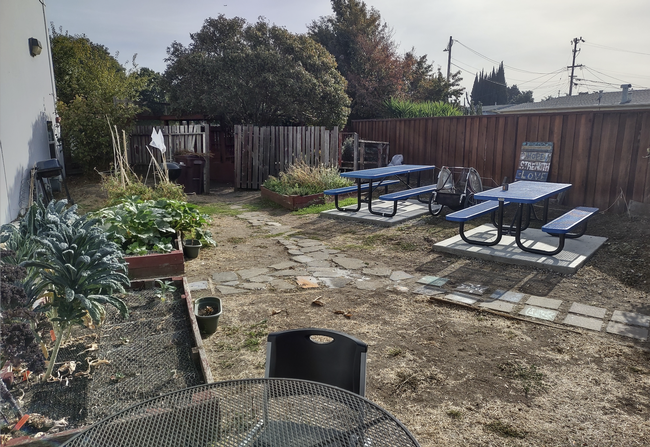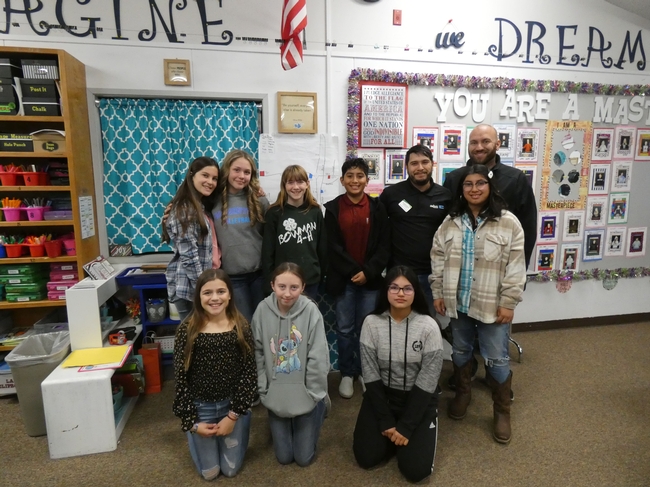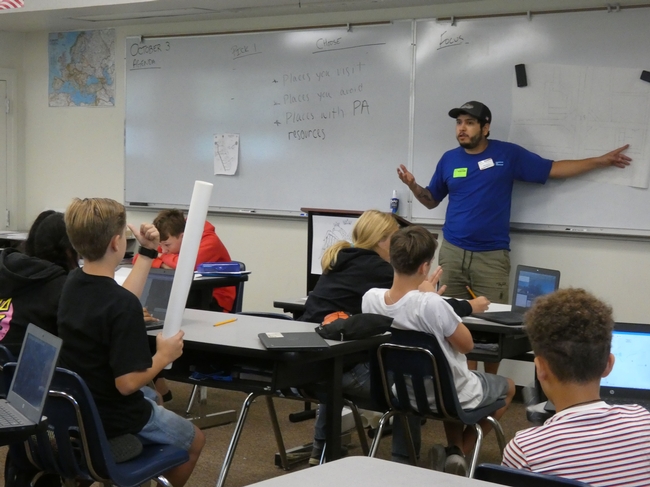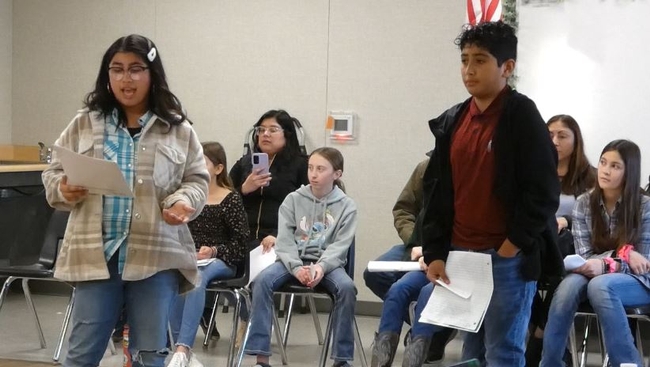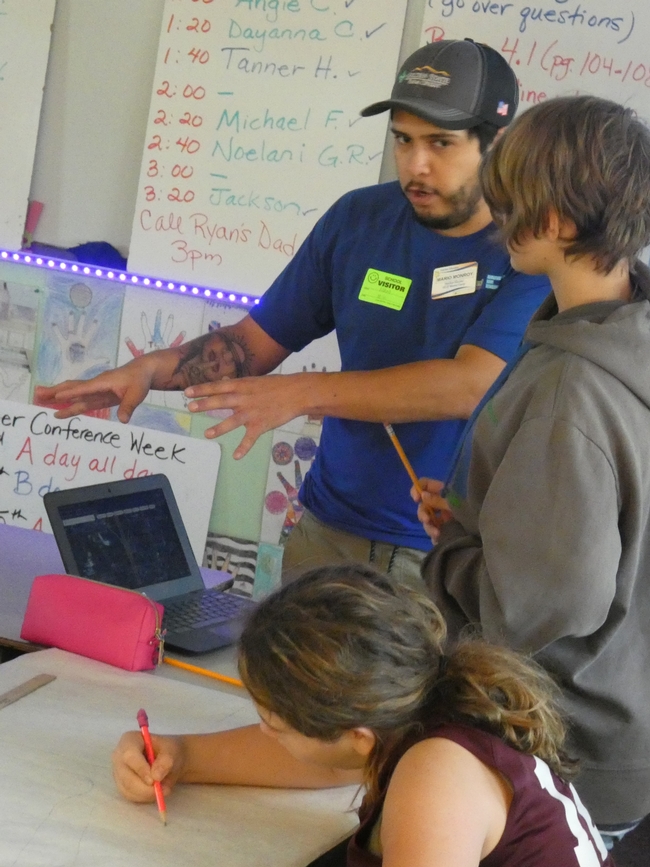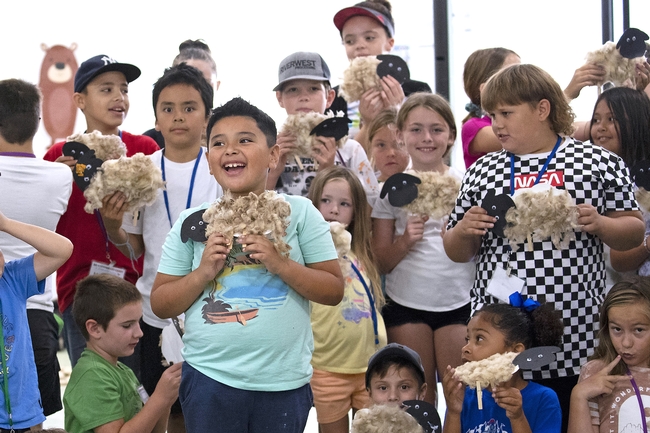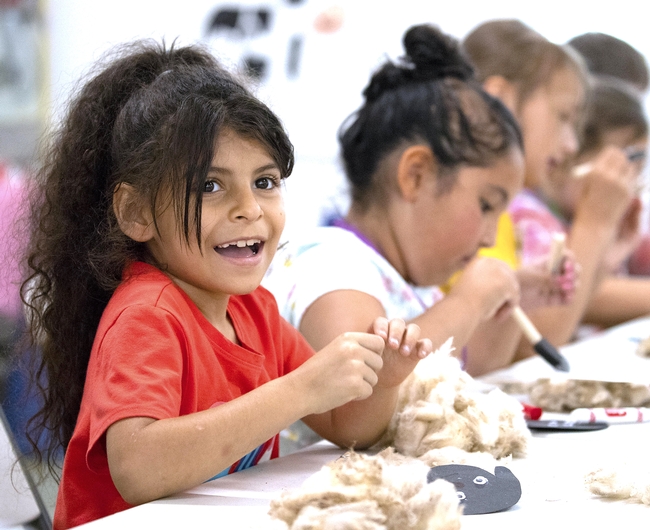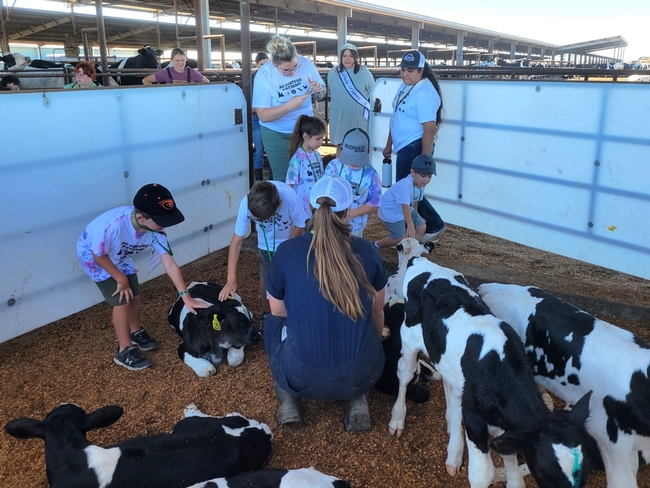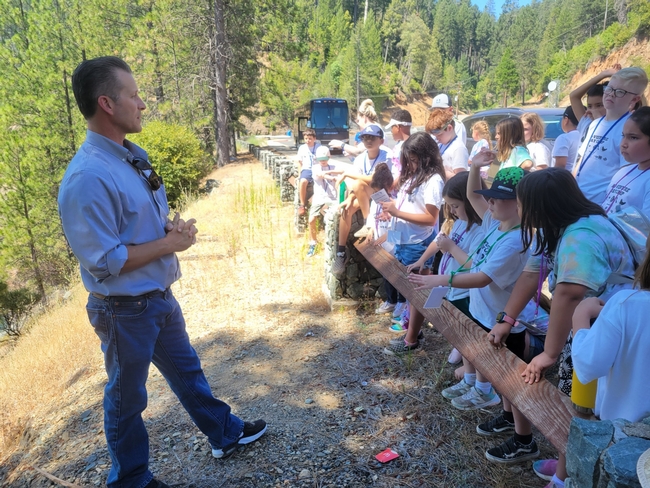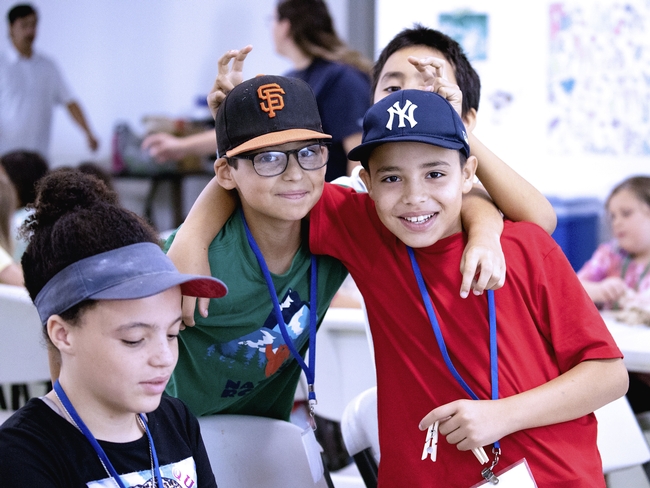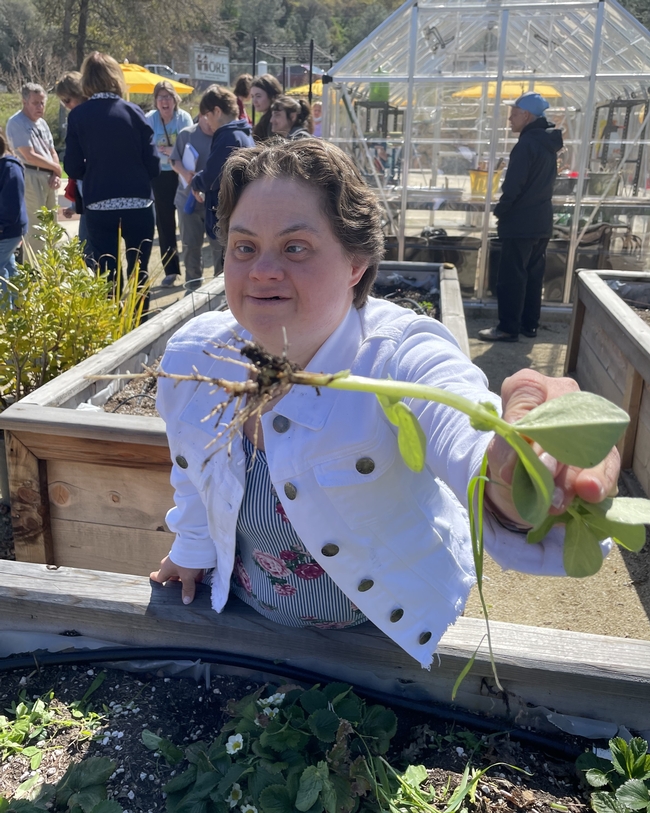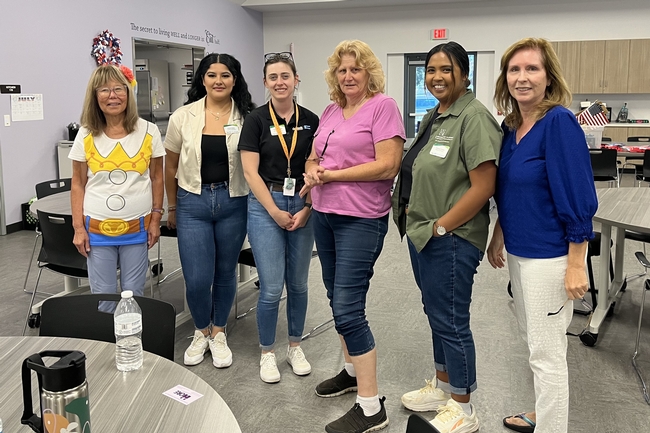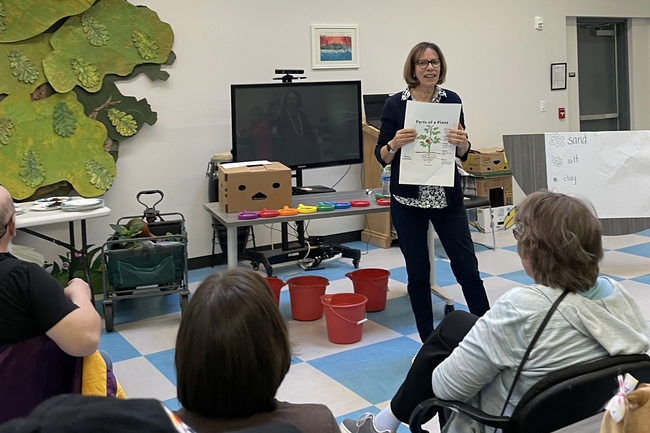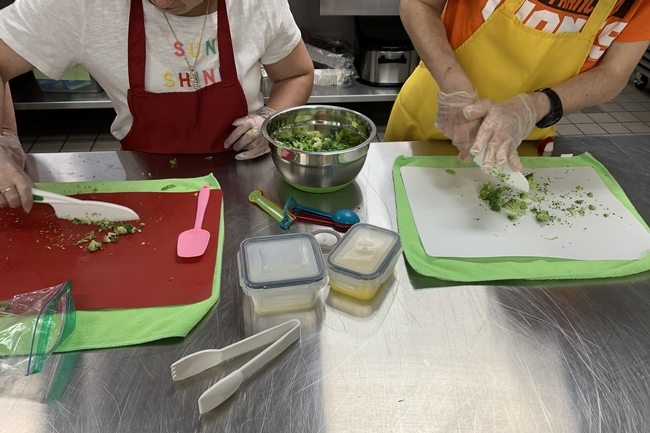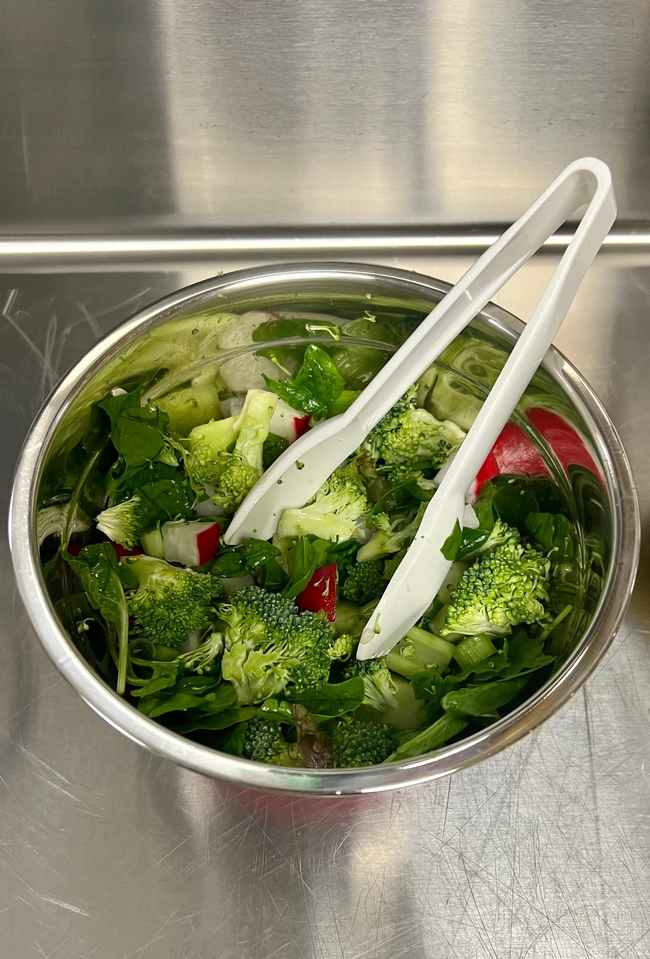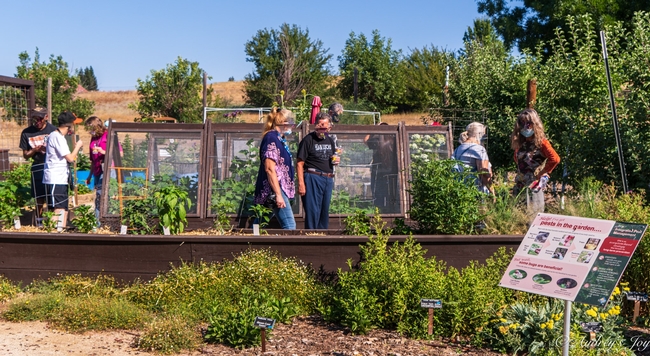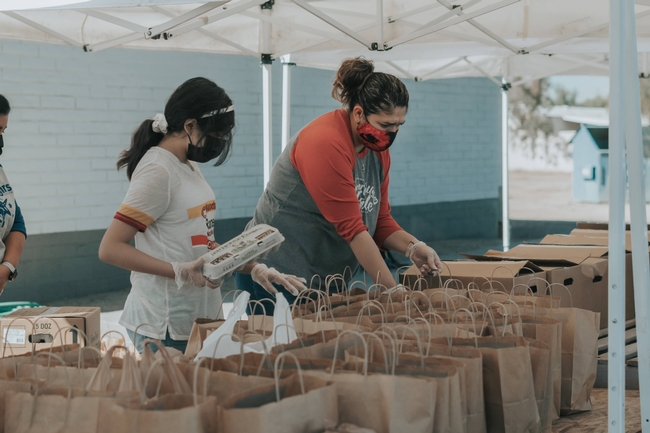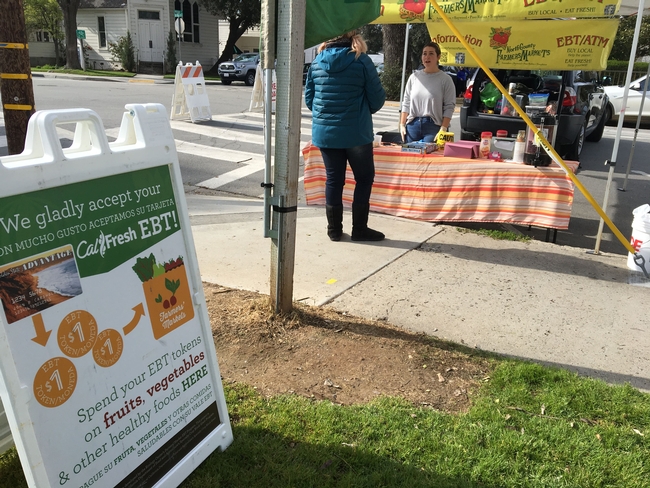Posts Tagged: CalFresh
Homeless people cultivate food, better health while gardening in Alameda County
Fresh fruits and vegetables are essential to a healthful diet, but it's hard to keep perishable foods on hand if one doesn't have a refrigerator or a home. To enhance the health of homeless people, the CalFresh Healthy Living, UC Cooperative Extension team in Alameda County has partnered with the South County Homeless Project to grow fresh produce for people staying at the emergency housing in Hayward.
For the past seven years, CalFresh Healthy Living, UCCE Alameda has been delivering nutrition lessons to residents of the South County Homeless Project, part of Building Opportunities for Self Sufficiency. The classes include Rethink Your Drink, Food Safety, Making Every Dollar Count, Eat Healthy Be Active Community Workshops, and Fresh from the Garden.
The South County Homeless Project facility houses 24 people for up to a year. With the help of the CalFresh Healthy Living, UC Cooperative Extension team, its existing garden was refurbished and redesigned. The large outdoor garden behind the facility offers therapeutic gardening opportunities to residents and provides food for their meals.
"I love the garden and when the cook cooks the vegetables, they taste amazing,” said one resident. “I am thankful for this garden and for having the CalFresh Healthy Living team.”
At one time, South County Homeless Project's backyard featured a flower garden. After years of neglect, weeds overtook the garden.
In 2022, CalFresh Healthy Living, UCCE Alameda proposed getting residents involved in growing food by resurrecting the garden with edible plants.
“Not only could we continue to engage residents in nutrition education classes, but we could also work together to reinvigorate their neglected garden,” said MaxFairbee, nutrition educator withCalFresh Healthy Living team,UCCE Alameda.
More than 15 varieties of herbs and vegetables planted
Residents and staff set out to replace the weedy beds with a vegetable and herb garden.
“We worked with South County staff and residents on the design, clean up, planting, harvesting and ultimately incorporating food from the garden into the kitchen for residents to enjoy the fruits of their labor,” Fairbee said.
For gardening expertise and support, Fairbee enlisted the UC Master Gardeners of Alameda County's Community Garden Team to help. While the CalFresh Healthy Living, UCCE staff continued providing nutrition classes, the UC Master Gardener volunteers trained the residents on the basics of gardening.
In April, after heavy rains, the group planted 50 seedlings, half donated by the UC Master Gardeners. They planted two varieties of lettuce,arugula, four varieties of tomatoes, zucchini, kale, onions, cucumbers, green beans, Swiss chard, kale, basil, cilantro, tarragon, thyme, parsley, rosemary, oregano and mint.
From garden to table
“In May, we harvested lettuce and in June, we harvested green beans, cucumbers, kale and onions,” Fairbee said.
The fresh vegetables and herbs were used to prepare salads, sandwiches and pasta dishes for the residents. Fairbee and the other educators have also used the fresh produce for cooking demonstrations and tastings as part of their Fresh from the Garden class.
"We have been able to use many of the veggies as sides or to go in the salad," said one of the South County Homeless Project cooks.
"One of the chefs used the zucchini in the pasta sauce, it was so good! I didn't really know you could use it that way!" said a resident.
After tasting summer squash andgazpacho made with tomatoes from the garden, a South County resident namedSelina said, "I was surprised how good the raw summer squash tasted and how the flavor was different after it was cooked. I'll definitely be adding more zucchini to my plate."
Challenges to keeping the garden going
To keep the garden healthy, they faced competition with plant-chewing snails, slugs and aphids and cats digging in the soil. Because the water source is over 200 feet from the garden, they run a long hose across the main path, along the parking lot to water the plants, then unhook the hose and stash it indoors after each use so that it won't get stolen.
Another challenge of maintaining the garden is getting enough residents and staff to volunteer to work on it.
“Although staff are supportive of the garden, none actually have time to work in the garden,” Fairbee said.
The residents harvest, wash and store the produce in the kitchen. Only four to six of the 24 residents are typically interested in working in the garden, pulling weeds and protecting the plants from pests – most are focused on getting a new job and a home. South County residents usually leave the temporary housing within a few months.
For more consistent garden maintenance, Fairbee is looking to other community groups for volunteers. He is also hoping to persuade the county government to install a water spigot close to the garden so they can install drip irrigation to water the garden.
“We'd like to work with the UC Master Food Preservers to teach residents how to preserve herbs and vegetables,” Fairbee said.
He hopes South County Homeless Project residents will continue gardening in their new homes to grow fresh vegetables so they can enjoy a more nutritious diet and better health.
Beyond the fresh food, the South County Homeless Project residents and staff enjoy the ambience of the garden.
"It's really nice to go back there and just sit, it's really peaceful," said one staff member.
A resident added, "(The garden) relaxes me from stress. I love the garden."
Sixth graders advocate for physical activity upgrades at school
Tehama County students empowered by CalFresh Healthy Living, UCCE educator and teachers
It's not uncommon for high school or college students to speak up and seek to improve their school environment. But at Evergreen Middle School in Tehama County, more than 100 sixth graders led the way to create healthy changes at their school.
As part of their health classes during the 2022-23 school year, the students researched the availability of spaces for physical activity, developed a survey gauging their peers' health awareness and needs, analyzed the results and data, and made recommendations for improvements.
“We learned that there's not a lot of places – except for Evergreen Middle School and some other parks around [our community of] Cottonwood – that have many physical activity places that you can easily get to or have access to,” said Bailey, one of the students.
They were guided by Mario Monroy-Olivas, a nutrition educator with CalFresh Healthy Living, University of California Cooperative Extension in Tehama, Shasta and Trinity counties. Locally administered by UC Agriculture and Natural Resources, CFHL, UCCE is one of the agencies in California that teaches nutrition to people eligible for SNAP (Supplemental Nutrition Assistance Program) – referred to as CalFresh Food in California.
Working alongside Evergreen teachers Roxanne Akers and Albert Estrada, Monroy-Olivas challenged the sixth graders to tackle a “Youth Participatory Action Research” project – a yearlong, multi-step undertaking typically designed for older teens.
“The fact that we're doing it with these younger kids, starting a lot sooner, I think it's super impactful for them to know that, together, collectively they can make huge changes that will create positive outcomes – not just for themselves but for an entire community,” Monroy-Olivas said.
Middle school students speak up at school board meeting
In February 2023, eight class representatives presented their findings to the Evergreen Union School District Board of Education. Speaking before the five-member board for 20 minutes, the young people were naturally a bit nervous.
“It was a little nerve-wracking at first, but it wasn't that bad, once we got up there and got it over with,” said Lilah, one of the presenters. “Me and a couple of my friends were doing pep talks and practicing what we were going to say.”
The students showed a composite map that they drew from their classes' investigation of spaces for physical activity in the area, and shared a brochure that outlined their research and survey results. In a survey of more than 80 of their peers, 92% of respondents said they needed more access to physical activity equipment during class breaks, recess and lunch.
“The board members were super impressed with the students, coming to the school board and doing this,” Monroy-Olivas said. “They said they haven't had students doing this kind of advocacy work; for them, it was a really big deal.”
In the end, the young people made a strong case for more water-bottle refilling stations, badminton equipment and balls for other sports, and stencils for schoolyard activities like hopscotch, four square and snail (a type of hopscotch game).
“We got almost everything we asked for, and the project we're working on now is to help put in the things we asked for,” said Lilah, adding that, during this current school year, the students (now in seventh grade) are working on acquiring the stencils and paint.
More than just equipment, students gain skills and confidence
While the promise of new gear is exciting for the youth, they are acquiring something even more valuable and enduring – a sense that they are empowered to make a difference in their community, according to Janessa Hartmann, UC Cooperative Extension community nutrition and health advisor for Tehama, Shasta and Trinity counties.
“Yes, it's important to want to do stencils and hydration stations and have more equipment,” Hartmann said, “but the bigger impact for the students is that they think: ‘Now I know that my health is important, now I know how to advocate for myself, and now I know that I can do that.'”
Monroy-Olivas said he observed tremendous growth in all the students, and especially in the self-confidence of the class representatives.
“I grew as a leader because I used to be really shy and hated talking in front of people, but through this project we're doing, this has really helped me be able to talk in front of crowds – and listen to others,” Lilah explained.
In a survey at the end of the sixth-grade project, the percentage of youth who answered “Yes, most definitely” to the statement “I want to make a difference in making my school/community healthier” jumped from 19% before the project to 44% after. And that percentage of “Yes, most definitely” replies jumped from 6% to 31% for the statement “I can use research results to come up with solutions or recommendations for making my school/community a healthier place.”
“We learned to promote what we want and try to get it as much as we can, so we can get more physical activities and more people can be included,” said Brian, another student working on the project.
“It's important so when we get older, we know how to voice our opinions and let people know what we're thinking,” added classmate Brooklynn.
Wishing that he had such an opportunity when he was growing up, Monroy-Olivas said he feels the students now know the power of their voice.
“I wholeheartedly believe that's the biggest win out of this whole project, that they're learning how to advocate for their own voice and change,” he said.
Ag-Venture campers dive ‘head first’ into agriculture, natural resources
UC Cooperative Extension team in Sutter and Yuba counties showcases UC ANR programs, community partners
When dozens of elementary schoolers gathered to watch a live calf birth at Tollcrest Dairy in Yuba County, their comments ranged from “disgusting but cool” to “I saw something that maybe I'm too young to see.”
Expanding horizons, growing knowledge and gently pushing some limits were at the heart of a four-week day camp, Ag-Venture, organized by the University of California Cooperative Extension office serving Sutter and Yuba counties.
Throughout July, more than 80 campers – ages 5 through 12 – explored agriculture and science topics through field trips across the region, hands-on activities and lively presentations by UCCE advisors, UC Master Gardeners, 4-H specialists, UC Master Food Preservers and CalFresh Healthy Living, UC educators. All these groups fall under the umbrella of UC Agriculture and Natural Resources.
A grant from The Center at Sierra Health Foundation funded this day camp for underserved youth focused on agriculture and natural resources – the first of its kind in the area. Exploring the themes of “Interesting Insects,” “Foods and Farms,” “Woods and Water” and “Awesome Animals,” the campers learned directly from community experts and UC ANR scientists.
“Some of the kids might think scientists are only wearing lab coats and working with genetics and DNA and human-based science, but here they got to see agricultural scientists and natural scientists,” said Rayna Barden, the 4-H community education specialist who led the camp. “It was a cool way to showcase what ANR does and what we have to offer.”
Youth gain wide range of experiences, knowledge
Visits to local farms and ranches – with many chances to greet the animals – were a highlight for many of the camp participants.
“I liked learning about agriculture and the interactive activities,” said a fourth grader. “I saw a baby cow coming out of its mama, and they [farm staff] had to use a tool. It was cool.”
A sixth grader said: “I learned that feed is made up of everyday items, like almond shells and beer hops!”
“Sheep, cows and goats have one stomach and four chambers,” added another sixth grader.
That digestive tidbit was absorbed by the campers after a visit with UCCE livestock and natural resources advisor Dan Macon at Sierra Foothill Research and Extension Center, a facility operated by UC ANR in Browns Valley.
“We have 4-H kids and FFA kids in high school who still don't know how the four chambers work!” Barden said. “These kids had it and it was so cool to see that they remembered that from a previous day.”
Time and time again, Barden said she was amazed at how much the campers retained. After a visit to Bullards Bar Reservoir, a seven-year-old was able to explain why the dam is curved. Another young boy could draw his own interpretation of the water cycle. And several campers talked about the rice presentation for weeks.
Whitney Brim-DeForest, UCCE county director for Sutter and Yuba counties and a rice advisor, had the participants touch and feel different rice seeds and varieties. The campers also got to plant a few rice seeds to take home.
“But their favorite part – and what they talked about for the rest of camp – was the tadpole shrimp,” Brim-DeForest said. “We brought some live and preserved specimens, and they loved them!”
Sparking ideas for future careers
One third-grade camper said she enjoyed learning the differences between agricultural pests and beneficial insects.
“And you can do stuff to help the good bugs,” she said, adding that she would like to pursue a career working with animals and nature.
Expanding awareness among young people of new career possibilities was exciting for Ricky Satomi, UCCE forestry and natural resources advisor for Sutter and Yuba counties. Using interactive exercises (such as those developed by California Project Learning Tree, another UC ANR-affiliated program), Satomi shared his knowledge about resource competition, watershed filtration and fire behavior in forest ecosystems.
“It's always a pleasure to introduce students to the natural resources where they live,” Satomi said. “This is particularly critical given the current workforce shortage we face in forestry; I hope their experience at Ag-Venture will spark interest in future forestry careers, where these students can work to better their local forest communities.”
Young people from local colleges and universities also gained invaluable experience during the camp. Four students helped prepare the camp: Yasmeen Castro Guillen (Chico State), Alana Logie (Yuba College), Jayla Pollard (Folsom Lake College) and Adam Yandel (Chico State). Three more helped lead the camp as counselors: Hector Amezcua (Yuba College), Alyssa Nott (Butte College) and Jillian Ruiz (Chico State).
“They did such a fantastic job, mentoring the kids and serving as positive role models, and we have seen tremendous growth in all of them, too – in confidence, skills and knowledge,” said Brim-DeForest.
A true community effort
Barden emphasized that the sweeping scope and in-depth, intertwining lessons of the camp were only possible through broad support from the greater community. Brim-DeForest highlighted the partnership with Yuba City Unified School District, as well as with Sutter County. Camp HQ was in Ettl Hall, a Sutter County building; campers visited the Sutter County Museum; they also met Yuba-Sutter public health officer Dr. Phuong Luu.
Additional collaborators included Melissa Ussery, CalFresh Healthy Living, UC nutrition program supervisor; Rene McCrory, 4-H secretary; Johnny Yang, UC Master Gardener and Master Food Preserver program coordinator; Matt Rodriguez, 4-H youth development advisor; and Nicole Marshall-Wheeler, 4-H youth development advisor.
“Honestly, we could plan all of this, but without the community's support, our program never would have worked smoothly,” said Barden, who grew up in the small town of Sutter. “Having all of our guest speakers, having all the people who were willing to have up to 50 kids on their property – it just shows how much our community is about our youth.”
Brim-DeForest said Sandy Parker, the camp nurse, exemplifies that spirit. A UC Master Gardener and 4-H alumna and volunteer, Parker also invited the campers to her family ranch, where she introduced the children to her farm animals and Great Pyrenees guardian dog.
The campers certainly appreciated the generosity, teamwork and energy that went into Ag-Venture. Barden said that many of the participants originally had only signed up for one or two weeks – but loved the camp so much that they asked to register for more. And she added that the “vast majority” of them said they want Ag-Venture to come back and would attend in the future.
“Our youth are just so resilient and so willing to learn,” Barden said, reflecting on the camp overall. “Whereas adults, we're usually a little more timid at things, these kids just were willing to dive in, head first, and be in that moment and try to take away as much as they could from what they were offered there at camp.”
Adults with disabilities learn nutrition, grow gardening and cooking skills
CalFresh Healthy Living, UC and UC Master Gardeners partner with nonprofit MORE in El Dorado County
A nonprofit serving adults with intellectual and developmental disabilities in El Dorado County, MORE has found kindred spirits in helping their clients live fuller and healthier lives – the staff and volunteers of University of California Master Gardeners and CalFresh Healthy Living, UC.
Since 2018, these programs – both affiliated with UC Agriculture and Natural Resources – have helped enrich the lives of about 60 clients at MORE, which offers services ranging from independent-living skills development to job training and placement.
“This is exactly the kind of partnership that we like to make with the community,” said MORE CEO Susie Davies, who has been with the Placerville-based organization for 40 years. “This has just been incredible; our people have learned above and beyond what we could even have imagined in nutrition and gardening.”
The three-party partnership, which Davies calls a “win-win-win,” offers a course that combines gardening and nutrition lessons, as well as a new cooking and food safety-focused class developed by educator Cailin McLaughlin in collaboration with MORE staff.
During one session, MORE clients enjoyed preparing a “plant part salad,” following a botanical lesson on the edible components of plants – fruits, roots, leaves, seeds and stems. “It was fun to cut the celery and broccoli,” said Jared (first names are used to protect privacy). “I like pouring the sauce in.”
“I liked everything about creating the salad,” said Deanne, another participant.
“MORE is the dream site, the best you could ever hope to go to, with the programming and the clients always being lovely and really just being down for anything,” said McLaughlin, a CalFresh Healthy Living nutrition educator at the Central Sierra UC Cooperative Extension office. “It's just a really cool place to be.”
CalFresh Healthy Living, UC is one of the organizations in California that teaches nutrition to people eligible for SNAP (Supplemental Nutrition Assistance Program). UC Davis administers the SNAP-Ed grant and UC Cooperative Extension educators deliver the lessons throughout the state.
‘Part of our MORE family'
Through the gardening and nutrition program, clients learn and apply their skills in the garden and greenhouse at the MORE facility and in the nearby Sherwood Demonstration Garden maintained by UC Master Gardeners of El Dorado County.
“The participants get a chance to harvest, plant, pull weeds and learn about integrated pest management, both in the vegetable garden and in the orchard,” said Tracy Celio, the local UC Master Gardeners program manager who worked with former CalFresh Healthy Living, UCCE educator Miranda Capriotti to develop the program.
“It's a very good program,” said Tony, a MORE client. “I can learn things.”
While experiencing the pride in bringing fresh produce to their home or to the MORE kitchen for use in the meal service, the clients are also taking away nutritious and healthy recipes. Jordan Postlewait, director of community access programs at MORE, said participants now know how to use ingredients from the garden to create dishes such as tomato salsa and fruit salad.
“They've taken the recipes that Cailin has given them and they go home and serve their whole group home what we had made for a snack,” Postlewait said. “They are paying attention to what they're eating.”
As a result of this awareness and knowledge of nutritious foods, Davies said that MORE clients are healthier, more energized and alert, and ready to learn. She is quick to credit the expertise and enthusiasm of McLaughlin, CalFresh Healthy Living, UCCE program coordinator Mariana Garcia, and the UC Master Gardeners staff and volunteers.
“They have the same dedication and commitment to excellence in their preparation for every session as our staff,” Davies said. “They just became part of our MORE family.”
“I like seeing Cailin and Tracy and all the staff who are my friends,” said Kenion, a MORE client.
Cooking lessons create possibilities for kitchen time, jobs
In April, two groups, each composed of six people, began participating in a new five-session course combining nutrition, food safety and basic cooking techniques. Each two-hour session included a nutrition lesson, a physical activity and time in MORE's commercial kitchen.
“It was fun getting in the kitchen and learning how to prepare my own meals,” Jared said. “I learned how to safely use a small skillet.”
Another participant, Kyle, said he uses the recipes to cook for his roommates. “I liked learning new cooking skills and recipes,” he said.
McLaughlin adapted a youth-oriented healthy eating curriculum, approved for use by CalFresh Healthy Living, UC, and tailored it for adults at MORE.
“The whole goal is to get them closer to an independent living circumstance, where either they can live in a group facility or have their own apartment – and knowing how to cook and identify healthy recipes is a huge component of that,” McLaughlin explained.
The guided kitchen experiences – and equipment like plastic safety knives – not only benefit the participants but also give their family members reassurance and confidence to include them in meal preparation.
“We've actually been asked by staff at MORE, and also by clients' parents, where we got the knives, because they would like to have their family member in the kitchen with them, if they can do it safely,” McLaughlin said. “They didn't know things like safety knives existed; they didn't know you could adapt a silicone food guard to keep them from burning themselves on a burner.”
In addition to enhancing the clients' family time, the cooking lessons could also set them up for future employment. Davies said she is in talks with a local chef about establishing a culinary training for the clients.
“This cooking program could be a preparation program for them to be involved in the culinary training program,” she said. “That's what we're really excited about.”
McLaughlin added that, for future sessions of the cooking and food-safety series, past participants have expressed interest in serving as kitchen aides and mentors.
Partners nurture clients' relationships with nature, community
Empowering clients with new skills and fostering a sense of ownership of the garden are both cornerstones of the partnership programs. Beginning in 2019, participants from MORE each adopted a tree in the Sherwood Demonstration Garden orchard to monitor and nurture.
“Almost every time they come to the garden, we check those fruit trees,” Celio said. “The trees are doing so many things throughout the year, so they're following the cycle: they watch the leaves drop; they watch the fruit come in; they see what a freeze does to their tree; they see what pests do to their tree.”
The participants experience the challenges of gardening – from managing rabbits and squirrels to coping with the loss of a pear tree due to disease – as well as its many joys.
“I liked seeing the butterflies and different plants; the butterflies drink from the bushes,” said Jen, a MORE client. “My favorite thing is the rose garden.”
At the same time, the clients have built strong relationships with the core group of UC Master Gardener volunteers and the dozen or so “vegetable garden crew” volunteers. Celio stressed that the garden programs, which were recently recognized by the statewide UC Master Gardeners program with a Search for Excellence Award, are truly collaborative.
MORE participants often bring their own ideas; one man, for example, became interested in composting and worked with MORE staff to establish a worm bin at the MORE facility garden.
“Every time I see that client, he will tell me how the worms were doing and he'll tell me how healthy the plants are that are growing next to the worm bin,” Celio said, adding that he also worked at a table during a MORE fair, teaching other clients and their family members about vermiculture.
Advocating for the greater good of the community is central to another CalFresh Healthy Living, UC collaborative project at MORE, in partnership with Stanford University's Our Voice initiative. Using an online tool and app, 12 clients have been taking photos and sharing feedback on their health and wellness experience at MORE, specifically about their walking trail. With that information, they are building a case to make the path safer and more enjoyable.
Responding to their feedback, along with the other partnership programs that are building vital skills and community, demonstrate to MORE's clients that they are appreciated and respected.
“The request from the people that we serve is that they want to be seen, they want to be heard, and they want to be valued by other community members,” Davies said. “And this is really showing them that they are valued and being seen and heard.”
UC ANR experts offer counsel as CalFresh benefits shrink, participants face hunger
Reduction of SNAP benefit deepens crisis of inflation, high cost of living, low wages
Starting this month, many of the estimated 3 million people in the CalFresh program – California's version of SNAP (Supplemental Nutrition Assistance Program) – will be facing hunger and making difficult decisions to meet their most basic needs. In late March, participants received the last of the pandemic-related emergency aid that significantly boosted their monthly benefits. The reduction varies by household size and income; for example, in April a single-person household could see a drop from $281 per month to $23.
“The emergency food allotments had a tremendous impact in our communities and across the nation,” said Shannon Klisch, academic coordinator for the Youth, Families and Communities Program for UC Cooperative Extension in San Luis Obispo and Santa Barbara counties. “One study estimated that these allotments kept more than 4 million people out of poverty across the U.S. in the last quarter of 2021, and reduced child poverty by 14%.”
SNAP increases during the pandemic made many Californians more food-secure, with some participants reporting that their allotments finally had been enough to feed their families for the month, according to Wendi Gosliner, a project scientist at the Nutrition Policy Institute (a program of UC Agriculture and Natural Resources). But, with the benefit reductions, food insecurity is emerging again as a serious concern.
“It is inconceivable that a nation this wealthy should have so many people experiencing hunger,” Gosliner said. “And here in California, with the high cost of living, ongoing inflation and extreme income and wealth disparities, people are being forced to explore every possible avenue just to feed themselves and their families.”
To help ensure they are receiving the maximum allotment, Klisch recommends that CalFresh participants – especially those who applied during the pandemic and are relatively new to the program – double-check their information.
“If the county doesn't have your most up-to-date information, call your county worker if you've changed your address, if you've experienced decreased income, if your housing costs have gone up, or if you have new expenses – like child or dependent care expenses or medical expenses – these can help you qualify for more CalFresh funds,” she explained.
For families with school-aged children, Klisch said they can stretch their food dollars and promote healthy eating by encouraging their children to eat breakfast and lunch at school through California's universal free school meals, and all families with children under 18 can watch for the next issuance of the P-EBT (Pandemic EBT) card, worth potentially hundreds of dollars.
In addition to these options for food assistance, Klisch pointed to programs that can help people save money on other household expenses, such as California Alternate Rates for Energy Programs (CARE) and Affordable Connectivity Program. Local food banks are also gearing up across the state to handle an expected surge in clients in need of emergency food; a list of California food banks can be found at cafoodbanks.org/our-members.
“We ask a lot of low-income families and workers to navigate and piece together various programs, applications, and benefits when we don't commit to a strong safety net,” Klisch said. “On the other hand, when people have enough money for food, everyone benefits through decreased health care costs and increased economic activity.”
Gosliner also said that people should look into their eligibility for WIC (Special Supplemental Nutrition Program for Women, Infants and Children), as well as the federal Earned Income Tax Credit (EITC) and CalEITC, poverty-alleviation benefits underused by Californians.
“People should make sure they are accessing all the safety net benefits for which they are eligible,” Gosliner said.
Market Match, other nutrition incentive programs can help
Through programs like Market Match, available at about 300 farmers markets across California affiliated with the Ecology Center, CalFresh participants can have their EBT benefits “matched” by their local market (usually up to $10 or $15 per visit).
“People are looking to get creative about how to stretch their food dollars, and Market Match is one way to do that,” said Klisch, who has led UCCE efforts to help promote the program along the Central Coast since 2017.
Striving to expand access to fresh fruit and vegetables and to support local farms, UCCE and CalFresh Healthy Living, UC worked with partners to increase CalFresh redemption at farmers markets in San Luis Obispo and northern Santa Barbara counties.
In 2017, about $48,000 in CalFresh and Market Match benefits were redeemed at farmers markets in the area. In 2022, the total was more than $207,000 – a 327% increase. According to Ecology Center figures for the entire state, CalFresh and Market Match spending at farmers markets jumped 161% from 2019 to 2021, up to $13 million.
Gosliner, whose research has shown that these nutrition incentive programs are associated with increased food security, noted that “the people who use Market Match absolutely love the program and feel it is incredibly helpful.” She also added that the California Department of Social Services is developing a pilot program that would offer match incentives for purchasing fruits and vegetables at larger food retailers.
Although the biggest of its kind, Market Match is just one of the programs across California that provide “matches” for healthy food purchases under the California Nutrition Incentive Program, which in turn is primarily funded by GusNIP (the nationwide Gus Schumacher Nutrition Incentive Program).
GusNIP dollars – and SNAP overall – are governed by the federal Farm Bill, typically renewed every five years and currently being negotiated by Congress.

